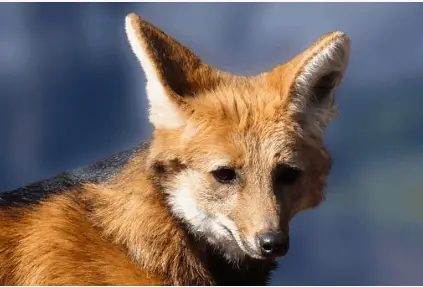Activity of text interpretation, aimed at students in the seventh year of elementary school, about the maned wolf. Despite his imposing size and the nickname "wolf", he is shy, lonely and practically harmless, preferring to keep his distance from human populations.. Let's get to know the maned better? So, carefully read the text “Maned: the great wolf of the Cerrado”! Then answer the various interpretative questions proposed!
You can download this text comprehension activity in an editable Word template, ready to print to PDF, as well as the completed activity.
Download this text interpretation exercise from:
SCHOOL: DATE:
PROF: CLASS:
NAME:
Read:
Related to wild wolves and domestic dogs, the maned wolf (
Haughty, slender and elegant, he is also known as mane wolf, red wolf, aguará, aguaraçu and jaguaperi, all names linked to its beautiful reddish-orange coat, which makes it one of the most beautiful Brazilian animals. In nature, it lives for about 15 years. At each gestation, which lasts just over two months, an average of two offspring are born.
Despite his imposing size and the nickname “wolf”, he is shy, lonely and practically harmless, preferring to keep his distance from human populations. It uses its prey to feed on small animals, such as rodents, armadillos and partridges, as well as various fruits from the Cerrado, such as araticum and lobeira (solanum lycocarpum), food heavily consumed by the guará.
It is normally seen circling large fields in the late afternoons and at night. In this routine, he usually crosses roads where he is often run over. The wide fragmentation of the Cerrado remnants means that animals have to leave forest refuges to feed and reproduce, becoming victims of automobiles and hunters, for example.
Available in:. (Fragment).

Question 1 - In the passage “[…] the largest canid in South America […]”, the text refers to:
( ) to the wild wolf.
( ) to the domestic dog.
( ) to the maned wolf.
Question 2 - Point out the fact that, according to the text, makes the maned wolf “one of the most beautiful Brazilian animals”:
( ) the different names it has.
( ) its haughty, slender and elegant bearing.
( ) its beautiful reddish-orange coat.
Question 3 - In “In nature, lives about 15 years.”, the underlined expression indicates:
( ) an exact amount of the maned wolf's lifetime.
( ) a hypothetical amount of the maned wolf's lifetime.
( ) an approximate amount of the maned wolf's lifetime.
Question 4 – In the segment "Despite the imposing size and the nickname 'wolf', it is shy, lonely and practically harmless […]", the underlined terms express:
( ) maned wolf actions.
( ) maned wolf states.
( ) Maned wolf ways of being.
Question 5 - Identify the food that, according to the text, is “very consumed by the maned”.
( ) the wolf girl.
( ) the araticum.
( ) little animals.
Question 6 – Chrysocyon brachyurus and solanum lycocarpum appear in italics because:
( ) are foreign expressions.
( ) are unusual expressions.
( ) are expressions with writing errors.
Question 7 – In the period “It is sighted normally circulating in large fields in the evenings and during the nights.”, the highlighted word could be replaced by:
( ) “commonly”.
( ) "quickly".
( ) “sporadically”.
Question 8 – In the sentence “[…] where he is often run over.”, the word “where” takes up:
( ) “great fields”.
( ) “roads”.
( ) “forest refuges”.
Question 9 – In “The wide fragmentation of the Cerrado remnants causes animals have to leave forest refuges […]”, the underlined part indicates:
( ) a wish.
( ) a necessity.
( ) a possibility.
By Denyse Lage Fonseca
Graduated in Languages and specialist in distance education.
 report this ad
report this ad